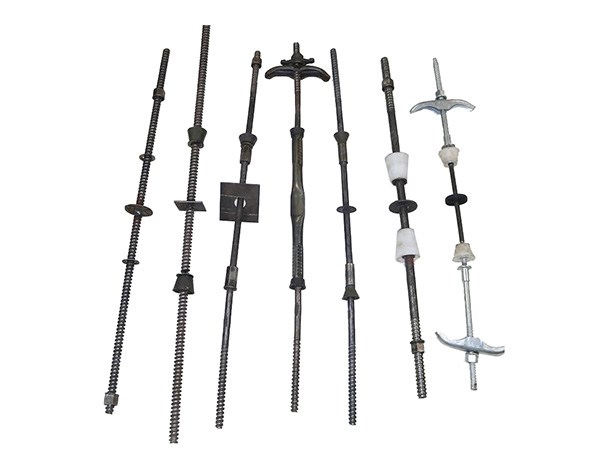- Site Navigation -

Three-Stage Waterstop Tie Rod
The Three-Stage Waterstop Tie Rod is a specialized structural component widely used in concrete construction,specifically designed to address two core needs:securing formwork during......
The Three-Stage Waterstop Tie Rod is a specialized structural component widely used in concrete construction,specifically designed to address two core needs:securing formwork during concrete pouring and preventing water penetration in waterproof-sensitive structures.Unlike standard tie rods that only provide formwork stability,this three-stage variant integrates a multi-layer waterstop mechanism,making it indispensable for projects like basements,underground garages,water tanks,tunnels,and retaining walls—where water seepage can cause structural damage or functional failure.
Core Structure and Working Principle
As its name suggests,the Three-Stage Waterstop Tie Rod features a three-section design,each serving a distinct purpose to balance structural support and waterproofing:
Formwork Fixing Stage:The outer sections(threaded rods)connect to formwork panels,allowing workers to adjust and lock the formwork’s position and spacing.This ensures the concrete maintains its designed thickness and shape during pouring and curing.
Waterstop Barrier Stage:The middle section(a thickened,often ribbed or rubber-coated rod segment)is embedded in the concrete.It acts as the first line of defense against water:the ribbed surface increases friction with concrete,while rubber gaskets or water-swelling strips(if equipped)fill微小gaps,blocking water from moving along the rod’s surface.
Post-Cutting Sealing Stage:After concrete curing,the outer threaded sections are cut off at the concrete surface.A sealing cap or waterproof mortar is then applied to the exposed middle section,creating a second waterstop barrier that eliminates potential seepage points from the cut end.
This three-stage design solves a major flaw of traditional tie rods:standard rods leave a continuous path for water to penetrate through the concrete.By combining formwork support with layered waterproofing,the Three-Stage Waterstop Tie Rod significantly enhances a structure’s water resistance.
Key Materials and Performance Specifications
The materials of a Three-Stage Waterstop Tie Rod are tailored to its dual role of load-bearing and waterproofing,with strict performance standards to ensure durability:
Rod Body:Typically made of high-strength carbon steel(e.g.,Q235 or Q355)or stainless steel(304 or 316 for corrosive environments).Carbon steel rods are cost-effective for general underground projects,while stainless steel is preferred for water tanks or coastal structures where rust could compromise waterproofing.
Waterstop Components:The middle section may include EPDM rubber gaskets(resistant to water and aging),water-swelling rubber strips(expand when in contact with water to seal gaps),or plastic waterstop collars(for non-metallic compatibility).
Performance Ratings:Critical specifications include tensile strength(minimum 450 MPa for carbon steel rods),yield strength(≥300 MPa),and water pressure resistance(able to withstand 0.6-1.2 MPa of water pressure—equivalent to 6-12 meters of water depth—without seepage).
Typical Applications
The Three-Stage Waterstop Tie Rod is a staple in projects requiring strict waterproofing.Common use cases include:
Underground Structures:Basements,underground shopping malls,and subway stations—where groundwater pressure poses a high seepage risk.
Water-Containing Structures:Concrete water tanks,swimming pools,and sewage treatment plants—where the tie rod must resist constant water contact and prevent leakage.
Tunnel and Retaining Walls:Road tunnels,railway tunnels,and riverbank retaining walls—exposed to soil moisture or surface water,requiring long-term waterproof stability.
High-Moisture Environments:Bathhouses,industrial workshops with high humidity,and coastal buildings—where corrosion and water seepage are dual threats.
Installation and Maintenance Guidelines
Proper installation and post-installation care are critical to maximizing the tie rod’s waterproofing effect:
Pre-Installation Check:Inspect the rod for cracks,rust,or damaged waterstop components.Ensure rubber gaskets are properly aligned and not deformed.
Formwork Assembly:Secure the outer threaded sections to formwork panels using nuts,ensuring the middle waterstop section is centered in the concrete form(to avoid偏移that reduces waterproofing).Tighten nuts evenly to prevent formwork deformation.
Concrete Pouring:Avoid direct concrete impact on the tie rods during pouring,as this could displace waterstop components.Vibrate concrete properly to ensure full contact with the tie rod’s middle section.
Post-Curing Steps:After concrete cures(usually 7-14 days),cut the outer rods flush with the concrete surface using a hacksaw or angle grinder.Immediately apply a waterproof sealing cap(made of plastic or metal)or fill the cut end with waterproof mortar to prevent water ingress.
Long-Term Maintenance:For water-containing structures,periodically inspect the sealing caps for cracks or detachment.Replace damaged caps promptly and reapply waterproofing if signs of seepage(e.g.,damp spots)appear near tie rod positions.
Advantages Over Traditional Tie Rods
Compared to standard tie rods or single-stage waterstop rods,the Three-Stage Waterstop Tie Rod offers distinct benefits:
Superior Waterproofing:Multi-layer barriers(middle waterstop+end sealing)eliminate seepage paths,reducing water damage risks by 80%or more in underground projects.
Cost-Effectiveness:It combines formwork support and waterproofing in one component,eliminating the need for additional waterproofing materials(e.g.,separate waterstop strips)and reducing labor costs.
Durability:High-strength materials and corrosion-resistant components extend the tie rod’s service life to 20-30 years,matching the lifespan of most concrete structures.
Compliance with Standards:It meets international construction standards such as China’s GB/T 51008-2016(Code for Waterproofing of Concrete Structures)and Europe’s EN 13001(Concrete Formwork Accessories),ensuring project safety and quality.
In summary,the Three-Stage Waterstop Tie Rod is a game-changing component that merges structural functionality with advanced waterproofing.Its three-stage design addresses the root cause of water seepage in concrete structures,making it a reliable choice for engineers and contractors prioritizing long-term durability and water resistance.








